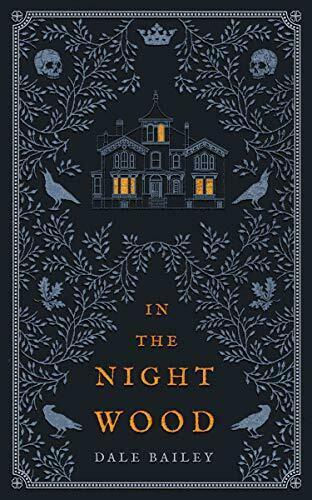The attractive cover of Dale Bailey’s In the Night Wood caught my eye in a bookshop, and the blurb on the back prevented me from putting it back on the shelf. This review will contain some spoilers, so if you feel similarly about the cover, go read the book first. It’s quite short.
In the Night Wood tells of an American couple, Charles and Erin Hayden, who inherit an old English manor once owned by a obscure Victorian fantasy writer named Caedmon Hollow. Hollow wrote only a single book, “In the Night Wood”1, which the husband has been obsessed with since childhood. In spooky cosmic fashion, this obsession led to him meeting and marrying Erin, one of the author’s descendants. Or maybe it was just a coincidence.

The couple’s young daughter, Melissa nicknamed Lissa, has recently died. Their relationship is further strained by Charles’s past infidelity. Grief and guilt keep them from returning to their jobs. So, with their lives in America effectively ended, they take the opportunity granted by the bequeathal of Hollow House to Erin, last surviving descendent of Caedmon Hollow, to move away to England and begin afresh. But neither one does the latter – Erin is deeply depressed, caught in her grief, and Charles is mostly interested in gathering material for a biography of Caedmon Hollow he plans to write.
The book within a book, “In the Night Wood”, is a fairy tale about a little girl named Laura2 who gets lost in a thick wood – clearly inspired by the one that surrounds Hollow House. Laura is stalked through this wood by a menacing figure called the Horned King. The story does not end happily; it’s implied that Laura does not survive her final encounter with the Horned King. Various characters comment about what a nasty tale it is, and how unsuitable for children, its ostensible target audience.
By now, the astute reader will have noticed some patterns. In the Night Wood is replete with men whose initials are CH, little girls whose names start with L and other similarly named characters. The very unsubtle theme is cycles and repetition. CH is married to E but cheats with S, and L must die.
Yet it felt to Charles Hayden like the culminating moment in some obscure chain of events that had been building, link by link, through all the thirty-six years of his life – through centuries even, though he could not imagine that at the time.
The writing style is elegant and just a little bit old-fashioned, suitably reminscient of Shirley Jackson’s Haunting of Hill House. Bailey’s literary and other allusions are welcome, if sometimes heavy-handed. The few pages of “In the Night Wood” interspersed throughout the book are distinct and highly evocative – together with references to unseen characters and incidents in the inner novel, they suggest a rich and haunting gothic fairy tale far more powerfully than more of its actual text would have. The biggest mistake you can make with this kind of thing is to show too much of it.
Ultimately, though, In the Night Wood is less about pagan deities in English woods than about Charles’s guilt and grief at the death of his daughter. The purpose of Hollow’s novel is to establish an original death of a young girl, which initiates a cycle. CH is married to E but cheats with S, and L must die. In meditating on this theme, Charles repeats a thought about the worm ourborous approximately three times too many, just in case it wasn’t obvious enough.
And then, finally, after spending two hundred pages on cycles and circles and inescapable fates, the novel climaxes on the lines below.
Maybe what had been didn’t have to be. Maybe you could break the circle, renounce fate, write your own story.
All you had to do was begin.
It’s a tentatively hopeful ending, acknowledging the inescapability of the consequences of past actions, but firmly asserting the possibility of breaking the cycle. And yet it doesn’t quite feel earned, perhaps due to the book’s very short length and the shocking suddenness of Charles’s change of outlook. You could argue that this abruptness is the point, but it felt hollow to me.
-
This novel joins the venerable tradition of works about works with the same name. Keeping with my usual practice, In the Night Wood will refer to the novel and “In the Night Wood” will refer to the novel within in the novel. ↩︎
-
This struck me as an oddly modern name for a protagonist written in the mid nineteenth century. ↩︎
 David Yates.
David Yates.